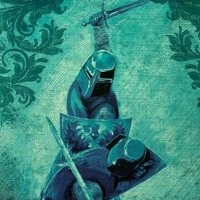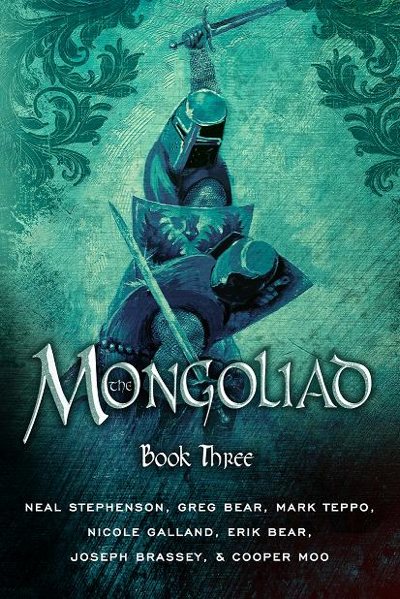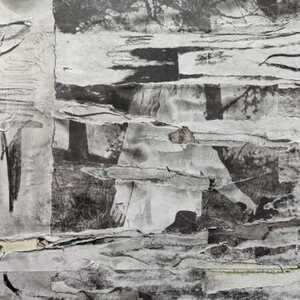
The Mongoliad, Book Three
by Neal Stephenson, Erik Bear, Greg Bear, Joseph Brassey, Nicole Galland, Cooper Moo, and Mark Teppo
47North

It’s difficult to know when to review a series of books. Though they’re all individually released, there’s the matter of continuity and the difficulty of making the distinction between the sum of the parts and the individual portion of the story that is released as a “volume.” And there’s the fear that somewhere in your infatuation, the writer will lose interest before you do. We don’t have any of these issues here.
Let’s talk about the Foreworld saga first, because this particular volume is the third and last book in the first trilogy in an ongoing series, and therefore we can hardly pretend it exists in a vacuum. The Mongoliad takes place in the thirteenth century, shortly after the Mongol horde’s initial push into central Europe. Strictly speaking, it’s alternate historical fiction, but actual events of the era, predating even the Middle Ages, are only vaguely known by most. With only an iconography of people and terms – Genghis Khan, the Knights Templar and the Crusades, the Holy Roman Empire – to serve as touch points, the deviations from our established chronology are hardly obvious.
It’s this hazy, hazy familiarity which lends the Foreworld saga its air of gothic fantasy. Guns are centuries in the future; the height of battlefield technology is black powder and long bows, and even these are obscure enough to give those who wield them the appearance of wizardry. A man wearing leather and chain-mail armor swinging a big sword is a lethal and nigh-invulnerable opponent to all except maybe a few hundred mounted Mongols trained to shoot arrows from horseback.
This trilogy begins in the aftermath of the battles of Legnica and Mohi, two decisive victories for the Mongols during their westward expansion. Genghis Khan is dead, and his heir, Õgedei, is now khagan, khan of khans. His nephew Ongwhe, looking to entertain his troops stationed near Legnica (now in southwest Poland), has established a gladiatorial circus, pitting his enslaved warriors against all willing locals. Haakon, an initiative of the Shield Brethren, a military religious order devoted to the Virgin but in truth predating Christianity, is victorious against one of Ongwhe’s own. He gains entry to the delights behind the scarlet curtain; however, his failure to eventually emerge from the tent of delights arouses suspicion in his fellow knights. Before long, due to this and other factors, a plan to assassinate the khagan is hatched.
Of course, with Neal Stephenson helping plot this book, this is merely a fraction of the underlying storyline, and I haven’t even begun listing the characters. The saga is rich in scenery, history, and drama, and it excels at the one thing it set out to do: present a literary effort with detailed descriptions of close-quarters fighting that doesn’t make anyone who does know how to hold a sword shake his head in frustration.
This is the real genesis for the series, and the reason why it involves so many authors. The group, which includes not only Stephenson but SF veterans Greg Bear, Mark Teppo, and others, is made up mostly of swordfighting enthusiasts. Many are writers with a fetish for hitting other people with sticks, while others are medieval fighting instructors drafted into this enterprise of writing. While Stephenson’s mastery of managing the multiple threads of a complex story is evident, the prose for the most part remains neutral but engaging, and is a lot smoother than you’d expect from such a lengthy roster of contributors. The fight scenes, which can take but a few minutes in the real world, often stretch for paragraphs and pages, as the minutiae of hand-to-hand combat are not only narrated, but analyzed and evaluated in the context of the fight. Some might find that attention to that particular detail overwhelming, but it’s preferable to the sort of writing that fawns over the weather and the landscape (though there’s a tasteful amount of that here too).
In terms of where it stands in the series, the third book has perhaps the most satisfying heft to it. The first two books have been spent weaving together story lines into a detailed tapestry, and at this point we are seeing some resolution to the lengthy and often bloody quests our characters have undertaken. The third volume also boasts a solid resolution, with just enough loose ends for the next series of books to pick up.
Here’s my final recommendation for digging into the Foreworld saga: the books are coming out at a regular and quite bearable pace, so that the reader isn’t spending the first third of a new volume getting reoriented and recollecting what has gone on before. If waiting for new novels is too much, the authors seem to be prolific in putting out shorter Kindle-based “side quests” set in the alternate history begun in The Mongoliad. I’m generally skeptical of books with multiple authors, but in this case the team is firing on all cylinders. Pick up the first book and perhaps we’ll be done with the series by the time the next Song of Ice and Fire book is out.
The Foreworld Saga: http://foreworld.com












